#theologians of the cross
Text
A Photo Essay: Following the Path of Apostle Paul - Day 6
Skala on the island of Patmos, Greece.
We hated to leave Samos. We enjoyed it so much.
Nevertheless, we were up early again to catch the ferry to our next adventure, the island of Patmos. The island hopping via ferry began in earnest.
I took a few photos of Pythagereio as the ferry sped away. We stopped at a few small island villages to pick up and drop off passengers. The island ferries have…

View On WordPress
#Bruce Stambaugh#Cave of the Apocalypse#Greece#island hopping#Monastery of St. John the Theologian#Patmos#Roadkill Crossing
1 note
·
View note
Text
@ the super smart and devout catholic dude in my religion class: hello
#nothing’s more attractive to me in a guy than someone who seems to have like all of CST memorized#also is wearing like 4 rosaries wrapped around his wrist like bracelets lol#i gotta step up my game clearly#nah i don’t care about superficially appearing catholic but i do wanna work up the courage to say more stuff in class#i mean i already do just bc i’m in my element as a baby theologian in theology class#but last year when i spoke up i seemed really smart cuz i was only surrounded by atheists/agnostics/normies#so of course i seemed like a catholic nerd#but now there are actually other people around me who are way cooler than me so i have new goals to aspire to#dang i wonder if he’s single#if i ever attain that level of bravery#his friend next to him also seems catholic but lemme just say sitting behind him seeing his screen is wildly entertaining#his search history is like like ‘cross tattoo’ ‘minecraft 2048’ ‘typing test’ ‘sacred heart of jesus’#covering a lot of bases there#huh so there are cool students at this university
0 notes
Note
do you happen to have any recs ie: books/readings on christian mysticism + theology? i've read a bit about catherine of siena for a history class in university and found her fascinating but i'm not quite sure where further to look as i am very much unfamiliar with the subject - ty !!!! <3
a strange quirk, you might say, of christianity is that we have mystical theology but we struggle to make practical sense of it. mysticism, especially when it presents in women, is often treated as dreaminess or romanticized rather than as authoritative theology (meister eckhart, augustine, and john of the cross, for instance, are regarded as authoritative in a very different way than catherine, hildegard, or teresa of avila, even though all of these women are doctors of the church and were regarded authoritatively in their lifetime). so i'll recommend some theologians who work within mysticism, but i earnestly think that the best way to learn about mysticism is by reading mystical texts themselves, my recommendations of which i'll list below.
bernard mcginn is arguably the foremost authority on christian mysticism. the varieties of vernacular mysticism, the crisis of mysticism, and his anthology the essential writings of christian mysticism is a very good primer with a wide variety of texts. caroline bynum walker is not a theologian but she's another major authority: holy feast and holy fast, jesus as mother, and wonderful blood are good books, but she's written a lot of wonderful papers as well: i especially like her reply to leo steinberg and women mystics and eucharistic devotion in the thirteenth century. michael sells is good too- a wonderful comparative religious theologian and i recommend his book mystical languages of unsaying.
in terms of mystics, simone weil's waiting for god and gravity and grace are indispensable; hildegard of bingen's scivias; teresa of avila's the interior castle, the way of perfection, and autobiography; marguerete porete's the mirror of simple souls; mechthild of magdeberg the flowing light of the godhead; mother maria skobtsova's essential writings; catherine of siena's dialogue; the book of margery kempe. you might also like the way of the cross by john of the cross and the work of meister eckhart. but i highly recommend getting mcginn's anthology- it was how i started off and is without a doubt the best way to begin getting a feel for mysticism.
74 notes
·
View notes
Text
Was Jesus transgender?

Jay Hulme has written a fascinating thread about how theologians have understood the gender of Jesus. Even though no one thinks of Jesus as transgender in the modern sense, it is pretty clear that Jesus has been seen as crossing the gender binary.
Jay Hulme is a transgender poet, performer and education and you can find his web site here! Jay is currently Poet-in-Residence at ‘The Poet’s Church’, St Giles-in-the-Fields in Central London.

Recently there was some drama where news outlets got angry at a sermon which supposedly claimed Jesus was trans. Obviously the sermon did not say Jesus was trans - but it did touch on some fascinating (and very old) theology surrounding Jesus and gender. So let's talk about that.
God is not male
First I've gotta explain the Trinity... which is way too complex for twitter Suffice to say that God is not male (despite what you may have heard) and is in fact all genders and none simultaneously Jesus is God made flesh, God embodied as human. As a human man, yes, but also...
If you've been on Trans Twitter you'll have seen the "Jesus is trans" jokes. Saying his chromosomes had to be XX because he couldn't have got a Y from his Father. The meme about his side would being from top surgery But people have been playing with Jesus' gender for centuries
And the reason that people have been playing with Jesus' gender in art and theology and all that for centuries, is that Jesus gives us REASON to. So, of course, as we expand our understanding of gender in the modern world, we expand that to trans stuff too.
For all mankind
So lets talk about how, historically, the "Masculinity" of Jesus has been seen and considered, shall we?
So the whole point of Jesus is that he comes for ALL of humankind. We are told that we are all capable of, and supposed to work towards, being "christlike" - after all, Jesus is the embodiment of a genderless (or genderfull) God. The point is not that Jesus is a man, but a HUMAN.
And Jesus is clear about the fact that he didn't come as "a man" but "a human". So clear that all of the Gospel writers agree on it. In fact, throughout the Gospels Jesus never uses the word "anēr" (male/masculine) to describe himself. He always uses "anthrōpos" (human).
Jesus is the human incarnation of a God who is all genders and none, all at the same time; a God that has created each of us in their own image - all of us, of every gender - and therefore Jesus is not simply "male", but "human", and theologians have long recognised this.
Jesus as mother
Understanding that Jesus isn't merely "male", theologians have often described Jesus as a "mother" - most famously Julian of Norwich, who wrote in the 1300's, said: "Jesus Christ therefore, who himself overcame evil with good, is our true Mother."
Julian of Norwich also stated "The mother can give her child to suck of her milk, but our precious Mother Jesus can feed us with himself, and does, most courteously and most tenderly, with the blessed sacrament, which is the precious food of true life"
This idea of the sacrament as breast milk was not unique to Julian - many theologians drew the connection between these life giving things - even reflecting Rabbinic understandings of the Manna from Heaven as breast milk to create a long thread of understanding.
But one of the most "contentious" parts of the sermon that started this furore and started this thread is a particular (and long held) understanding of Jesus' side wound. Obviously, Julian has thoughts on that, too...
Julian says: "The mother can lay her child tenderly to her breast, but our tender Mother Jesus can lead us easily into his blessed breast through his sweet open side, and show us there a part of the godhead and of the joys of heaven, with inner certainty of endless bliss."
Jesus side wound
Medieval Christians were OBSESSED with Jesus' side wound. It was the highlight of artistic depictions, the focus of sermons, the content of visions. And one of the main things they saw it as, was some kind of portal...
And by "portal", I do, of course, mean vagina. And that's what the oh so contentious sermon said - "look, medieval christian art saw Jesus' side wound as a vagina. Let's talk about that."
The idea is that Jesus gives life. Like a mother giving birth. Jesus raising Lazarus from the tomb, Jesus himself rising from the tomb, they both involve the miraculous drawing out of human life from a dark cave, along a tunnel, and into the light. Sounds a lot like childbirth.
We say that Christ died so that we could live. The Bible says it a lot. Many theologians, living in a time where death in childbirth was common, and childbirth itself could be horrifically painful drew the connection between Christ's physical death on the cross and childbirth.
Theologians saw Jesus' agony on the cross as a form of 'labour' as he 'birthed' new life for all of us. And so, when the soldier pieced his side, proving he was dead, and "blood and water" came out, they saw that as the moment of 'birth'. Like blood and water come in childbirth
With that in mind, when an opening in a body brings forth water and blood, and in the midst of that water and blood comes new life... it's fair to think of it as a vagina. So medieval artists, depicting that moment, depicted Jesus' side wound as such. It was a thing.

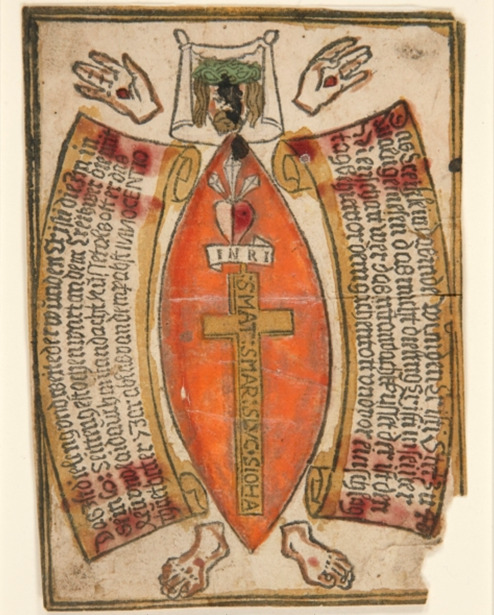

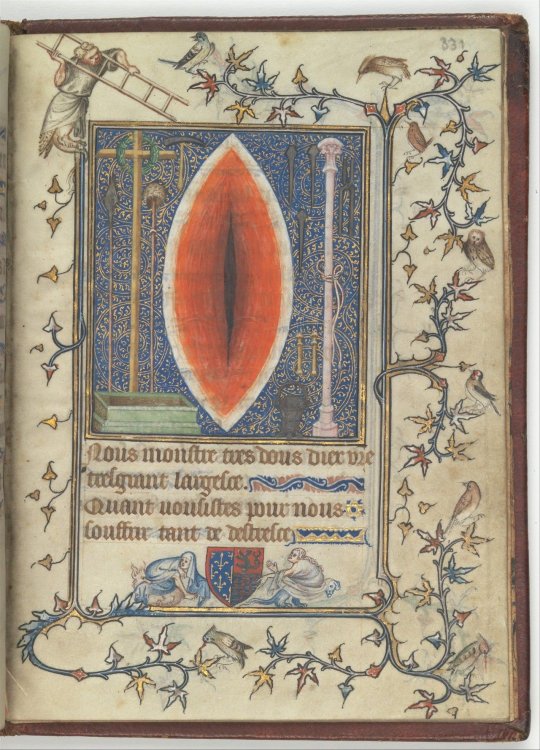
The femininity of Jesus
There's also all the theology that surrounded Jesus' actions: theologians living in times of strict gender roles obsessed over the "femininity" of Jesus feeding and serving others. Even speaking to women as if they were equal. Of him taking the "feminine role" in his interactions
But this thread is already very long...
In summary: If you think it's heresy to see Jesus as "feminine" or "mother" or anything other than a masculine macho manly man, you're wrong. And if you think it's "modern woke nonsense", then you've not been paying attention to centuries of theology, or the Gospels themselves.
One day I'll do a whole thread on how it actually is Big Trans Vibes for God to shrink down to a single "gender" and body to walk among us as Jesus, and how weird that must have been for Jesus to suddenly be "male" and not "the genderweird vibe of God" but that's for another time
Ppl have been going BUT WHAT ABOUT 'THE SON OF MAN' and my friends, the earliest Gospels we've got are Ancient Greek and Luke 9:22 says "υἱός τοῦ ἀνθρώπου" υἱός is often translated as "male child" but regularly applies to female children ἀνθρώπου means "human / humanity"
Full twitter thread here!
Photo from the Norwegian play Jesus, the Queen of Heaven, where the Norwegian transgender pioneer Esben Esther Pirelli Benestad played Jesus. Photo by Fin Serck-Hanssen.
#trans#transgender#queer#lgbt#lgbtqa#jesus#theology#gender theology#christianity#essential#history#religion
736 notes
·
View notes
Text
Today is Easter Sunday.
Today is Trans Day of Visibility.
Today is day 176 of genocide.
This year the lectionary gives us Mark's account of the Resurrection, with its fearful cliffhanger ending — an empty tomb, but Jesus's body missing. And isn't that unresolved note fitting?
In the face of so much suffering across the world, it feels right to be compelled to sit — even on this most jubilant of days — with the poor and disenfranchised in their continued suffering.
Mark's account:
Just days before, the women closest to Jesus witnessed him slowly suffocate to death on a Roman cross. Now, now trudge to his tomb to anoint his corpse — and find the stone rolled away, his body gone. A strange figure inside tells them that Jesus is has risen, and will reunite with them in Galilee.
They respond not with joy, but trembling ekstasis — a sense of being beside yourself, taken out of your own mind with shock. They flee.
The women keep what they've seen and heard to themselves — because their beloved friend outliving execution is just too good to be true. When does fortune ever favor those who languish under Empire's shadow?
Love wins, yet hate still holds us captive.
I'm grateful that Mark's resurrection story is the one many of us are hearing in church this year. His version emphasizes the "already but not yet" experience of God's liberation of which theologians write: Christians believe that in Christ's incarnation — his life, death, and resurrection — all of humanity, all of Creation is already redeemed... and yet, we still experience suffering. The Kin(g)dom is already incoming, but not yet fully manifested.
Like Mark's Gospel with its Easter joy overshadowed by ongoing fear, Trans Day of Visibility is fraught with the tension of, on the one hand, needing to be seen, to be known, to move society from awareness into acceptance into celebration; and, on the other hand, grappling with the increased violence and bigotry that a larger spotlight brings.
The trans community intimately understands the intermingling of life and death, joy and pain.
When we manage to roll back the stones on our tombs of silence and shame, self-loathing and social death, and stride boldly into new, transforming and transformative life — into trans joy! — death still stalks us.
We are blessedly, audaciously free — and we are in constant danger. There are many who would shove us back into our tombs.
And of course, the trans community is by no means alone in experiencing the not-yet-ness of God's Kin(g)dom.
Empire's violence continues to overshadow God's liberation.
The women who came to tend to their beloved dead initially experienced the loss of his body as one more indignity heaped upon them by Empire. Was his torture, their terror, not enough, that even their grief must be trampled upon, his corpse stolen away from them?
The people of Gaza are undergoing such horrors now. Indignity is heaped on indignity as they are bombed, assaulted, terrorized, starved, mocked. They are not given a moment's rest to tend to their dead. They are not permitted to celebrate Easter's joy as they deserve. They are forced to break their Ramadan fasts with little more than grass.
Those of us who reside in the imperial core — as I do as a white Christian in the United States — must not look away from the violence our leaders are funding, enabling, justifying.
We must not celebrate God's all-encompassing redemption without also bearing witness to the ways that liberation is not yet experienced by so many across the world.
This Easter, I pray for a free Palestine. I pray for an end to Western Empire, the severing of all its toxic tendrils holding the whole earth in a death grip.
I pray that faith communities will commit and recommit themselves to helping roll the stones of hate and fear away — and to eroding those stones into nothing, so they cannot be used to crush us once we've stepped into new life.
I pray for joy so vibrant it washes fear away, disintegrates all hatred into awe.
In the meantime, I pray for the energy and courage to bear witness to suffering; for the wisdom for each of us to discern our part in easing pain; for God's Spirit to reveal Xirself to and among the world's despised, over and over — till God's Kin(g)dom comes in full at last.
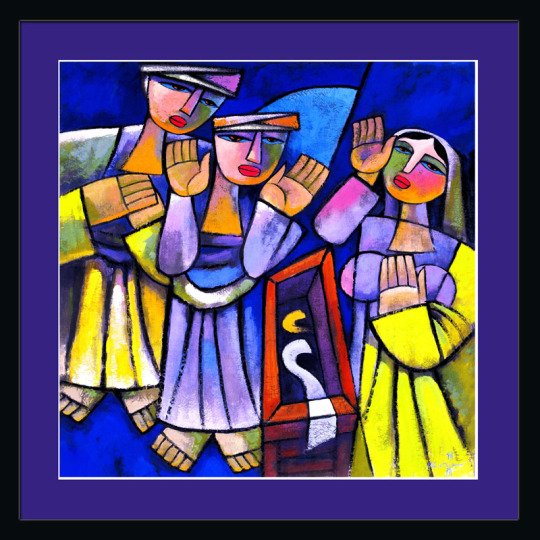
"The Empty Tomb" by artist He Qi.
45 notes
·
View notes
Note
Hello. This is a rather mundane question considering all the things, but I got curious. Does Hebrew have accents? How do they vary in and out of Israel?
I understand if you choose not to reply as this is a difficult time for you. In any case, take care🩷🩷🩷
Hi Nonnie! No, don't worry, all questions that are truly interested in Jewish culture are welcome! ^u^
TBH, something to remember about Hebrew is that it has quite a unique history. To the best of my knowledge, it is the only language that was used on a daily basis as the lived in language of a native population, then "died" as a result of Jews being exiled. As they found themselves in other countries, they had to speak the local language. They didn't abandon Hebrew, but it stopped being the langauge in which they lived their daily lives. Hebrew became the language of prayer, of scripture study, and terms from it bled into the local languages Jews spoke, creating Jewish versions of these languages (Yiddish being the Jewish version of German, Ladino being the Jewish version of Spanish, Yevanik being the Jewish version of Greek, and there are also Jewish versions of Arabic and other languages, too), so Hebrew still had an impact on Jews, and they were still connected to it... but it was no longer a "living" language. It was closer to what Latin is today. A language in which religious ceremonies are conducted, that theologians study, but not a language that anyone conducts their daily life in.
Then, as a part of the project of reclaiming and reviving the Jewish native life in Israel that came to be known as Zionism, people set out to revive our native language, too. There was a realization that it had to be adapted to modern life, give it terms for things that didn't exist 2,000 years ago, so it would be useful for people who wanted to conduct their daily lives in Hebrew again. And that's how the last of the Canaanite languages became the only "dead" language to be revived, and return to be the lived in language of its native people.
I mention this unique history, because modern Hebrew isn't the same as biblical Hebrew (though about 60% of modern Hebrew IS biblical). It means if there were different Hebrew accents during biblical times, we don't know it for sure.
At the same time, the fact that Jews were spread out in the diaspora, and their pronunciation of Hebrew (as a dead language) came to be influenced by the local languages they spoke while in exile. So a Jew who returned to Israel from the diaspora in Germany, a Jew who returned to Israel from the diaspora in Argentina, and a Jew who returned to Israel from the diaspora in Yemen do not have the same accent when speaking Hebrew.
But these are not considered regional accents of Hebrew in the same way that you can find different regional accents of English when traveling across England... If we put aside the accents of Jews returning to Israel, and instead we look at the accents of Jews born in Israel, the ones born into speaking modern Hebrew, there's a myth of a Jerusalem accent. I say myth, because you'll hear all over Israel people swearing, that Jerusalemites pronounce a few words differently. The most common example is the word 'mataim' (which means two hundred), and many Israelis insist Jerusalemites pronounce it ma'ataim, with the first vowel prolonged and emphasized. I have lived in Jerusalem since 2002 and I have never heard it. I think in this sense, regional accents are usually, at least in part, a product of geography. It determines how far apart people live, how much they interact, how much they hear others speaking the same language as they do. The smaller a country, and the easier travel in it is, the fewer accents it's likely to produce. And I think that's the main reason why there aren't really accents in Israel (other than those of people who came to speak Hebrew as a second language), because it's a very small country, and because today, it's pretty easy to travel in it (you can cross it from the most northern point to the most southern one in slightly over 5 hours).
I hope that kind of answers it? Thank you for the kind words, I hope you're well, too! xoxox
#ask#anon ask#israel#hebrew#jewish history#jewish#jew#jews#jumblr#frumblr#native israeli#native history#cultural revival#language revival#native revival
79 notes
·
View notes
Text
Gentleness is given to those who have learned that God will not have his kingdom triumph through the violence of the world, for such a triumph came through the meekness of a cross.
Stanley Hauerwas, Hannah's Child: A Theologian's Memoir
178 notes
·
View notes
Text

Saint Teresa of Avila
Doctor of the Church
1515 - 1582
Feast Day: October 15
Patronage: bodily ills; headaches; lacemakers; loss of parents; people in need of grace; people in religious orders; people ridiculed for their piety
St. Teresa of Ávila, baptized as Teresa Sánchez de Cepeda y Ahumada, was a prominent Spanish mystic, Carmelite nun, writer of the Counter Reformation, and theologian of contemplative life through mental prayer. She was a reformer of the Carmelite Order and is considered to be a founder of the Discalced Carmelites along with John of the Cross.
Prints, plaques & holy cards available for purchase here: (website)
93 notes
·
View notes
Text
I went to do the stations of the cross with my family this past weekend for good friday/easter not because i’m religious but because they are and i enjoy latently existing in religious spaces. However this time around I realized something that I think really got to the heart of why I stopped wanting to follow Catholicism.
During the stations there was this repeated phrase (I dont think this is universal but it might be) that says “Let me die than ever sin again” and I got to thinking about that and.
In its kindest, most gentle interpretation, sin is simply an action that brings us away from god. It’s the root of suffering because we aren’t one with god. The implications here are that sin makes god sad because he wants to be close to us absolutely and that for us to stop sinning makes us one with him, stops our suffering, and allows us to live as our most true, authentic selves. There’s a lot to unpack with that as it pertains to free will but that’s not what I’m here to talk about today.
What struck me today was how this must sound from god’s perspective. Or at least, from the perspective of a god who is truly omnipotent and unconditionally loving.
Now, I’m no theologian and I am just one guy but if I was a god, or ANYONE with any relationship with another human being, I don’t think that is… something I would want said about me? We are encouraged to view the relationship with god as a parent-child, close friend, and even in some CERTAIN, SPECIFIC, VERY TENUOUS contexts even as romantic. (Beware the blapshemy on that last one lest you be burned at the stake). I wouldn’t want someone I loved thinking that every time they fucked up they should just die. That’s horrible. I’d want them to get help for that. Even if they were trying, or even not trying, or not trying very hard, I wouldnt want them to feel like their closeness to me was contingent on them never screwing up ever. To the point where they’d rather die than mess up again. I’d look at them and say ‘girl get help.’
It also doesn’t sound like true love to me. It doesn’t sound like the words of someone who is trying their best but knows they are fallible and will be loved no matter what. It just sounds like self flagellation for the sake of self flagellation which I guess if you’re into that, cool.
That’s just me though. Maybe i’m a kinder god than most.
#current mood#religion#catholicism#this is not an open debate post btw in case any fundies or catholics find this#you will be blocked#ok to reblog for my non religious and ex catholic homies#or people who are chill about religion
40 notes
·
View notes
Text
So how did we get from this

Dedicated to his Worshippers, George Frederic Watt (1817-1904)

To this?
A brief history of Mammon
Addendum Because We Can't Have Nice Things: this essay is in no way meant to be a "critique", criticism, or personal attack against Helluva Boss/Hazbin Hotel/Vivziepop as I am, in fact, a big fan of all three! I actually loved the newest episode and Mammon as a character. Seeing him in motion, I think he looks damned near perfect as a modern take on the King of Greed. I wrote this ONLY for educational purposes.
Mammon is a Chaldee (the Semantic language of ancient Chaldeans, the people of a small Mesopotamian country who were later absorbed by the Babylonians) or Syriac word meaning "wealth" or "riches".

The Worship of Mammon, Evelyn De Morgan (1909)
He is best remembered from the Sermon on the Mount from Mathew 6: 24 (King James version): “No man can serve two masters: for either he will hate the one, and love the other; or else he will hold to the one, and despise the other. Ye cannot serve God and mammon.”
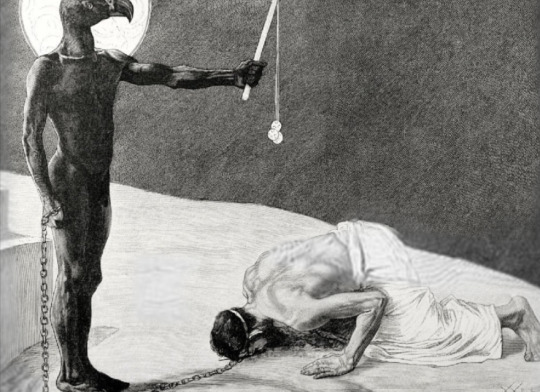
Some scholars believe Mammon might have been loosely based on Dīs Pater, originally a Roman God of mineral wealth and fertile lands who was later merged with the chthonic deities of the underworld Pluto and Orcus (because minerals come from underground). Pluto was depicted in the Divine Comedy as "wolflike demon of wealth"; wolves in the medieval times were symbols of greed. Others think he might have been an ancient Syrian god, though no trace of his cult or temples exists.

Mammon transformed over time from an abstract concept to major demon. This is thanks to later philosophers and theologians such as Saint Gregory of Nyssa, a third century Byzantine scholar, Archbishop of Constantinople John Chrysostom, and Peter Lombard, bishop of Paris from 1159 to 1160. His book of Four Books of Sentences (Sententiarum libri IV) was the standard theological text of the Middle Ages.
Mammon was assigned the sin of greed according to the Peter Binsfield classification of demons.
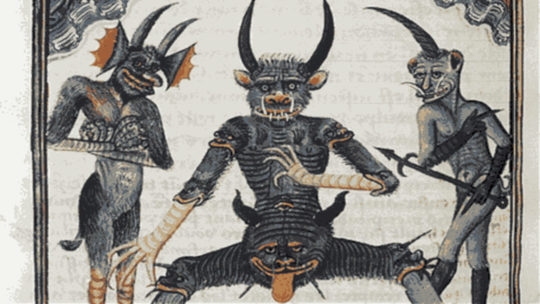
John Milton of Paradise Lost fame imaged him as a fallen angel. He is described as being stooped over (literally the "least erected" of Lucifer's demonic host) because he always has his eyes downward looking for gold and would rather use Hell's resources to finance his lavish lifestyle than wage war against Heaven.

In Edmund Spenser's 16th long poem, The Faerie Queene, Mammon is a “uncouth, salvage, and uncivile wight” who sets up his cave of riches right next to the entrance to the underworld. Subtle, huh? He tries to tempt Sir Guyon, the protagonist of Book II, with all his fabulous wealth, arguing that he could use it for good. (This is a religious-moral-political allegory about temperance, so you can guess how well that went.) He shows up again in Jacques de Plancy's Dictionnaire Infernal as Hell's ambassador to England. Yes, really.
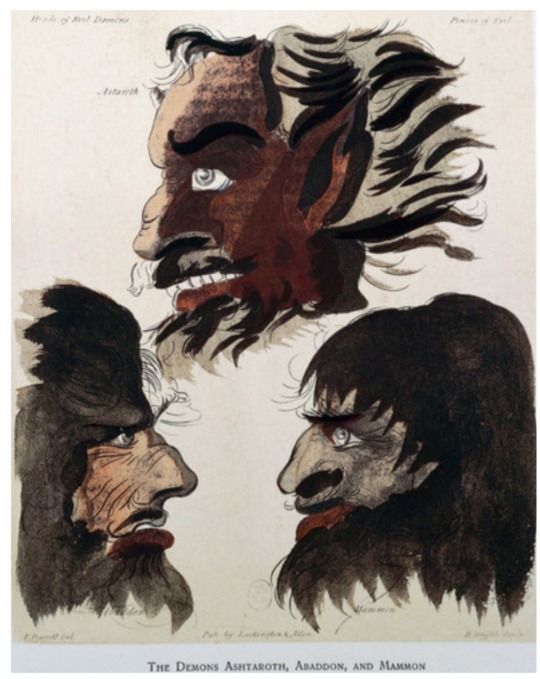
Just like in Biblical times, reformists used Mammon as a symbol of exploitation and unfettered capitalism during the industrial age.

Fun fact: Mr. Burns lives at the corner of Croesus and Mammon street.
So how does Vivziepop's version compare to the historical Mammon? I dunno, he hasn't appeared in the show yet. It's not my favorite design, but I like the fact that half the fandom was expecting him to be the Big Bad of Helluva Boss, and he's a just big heckin' chonk who sort of looks like a demented Dr. Suess character crossed with a demonic air freshener. It's a silly design for a silly dude, but he could be more dangerous than he looks...
81 notes
·
View notes
Text
I think we (Queer Christians) should bring back the Feast of Fools! Here's my pitch:
Medieval Christians celebrated the days following Christmas with societal inversion. If God became a vulnerable child born into poverty, then the best celebration should invert the social order: master and servant, clergy and laity, man and woman. The Feast of Fools–held on January 1st–was the most notable celebration of cosmic inversion. Developed in the late 12th and early 13th centuries, the tradition of the feasts continued until the 16th century. (1)
The festival is popularly misunderstood as a celebration of sacrilege, a result of its apparent burlesque of religion. Yet, the festival’s role reversals were prescribed by clergy, and the "fools" represented those chosen by God for their lowly status. From surviving 13th century manuscripts–notably, the Play of Daniel from Beauvais Cathedral and the Office of Joseph from Laon Cathedral–it is clear that some Catholic Churches in France sanctioned cross-dressing for liturgical purposes. (2) In fact, the Feast of Fools is remarkable for being sanctified rather than sacrilegious.
Many anthropologists of religion have argued that “sacred play,” or “ludic ritual,” is central to how religious behaviors function. (3) Although play may seem counterintuitive to religion, absurdity and holiness often go together, especially considering the role reversals and revelry of the Feast of Fools.
Literary critic Mikhail Bakhtin made a similar argument about the “carnivalesque.” (4) When absurdity is celebrated in religion–when a society’s usual rules are suspended–observant revelers can stretch the boundaries of their identities or reverse their social roles. Men become women; laity become clergy; God becomes a helpless infant; death becomes life. It is on the strength of the absurd that religions delve into hope and new ways of becoming. (5) “Sacred play” is reality altering work, a cornerstone of religious enlightenment and religious embodiment.
In 1969, theologian Harvey Cox proposed that an imitation of the medieval Feast of Fools could rejuvenate modern Christian spirituality, lamenting that the tradition has forgotten sacred play. (6)
As found in the Medieval Feast of Fools, the joy of inversion and freedom of death were, at one point, celebrated in Christian tradition through cross-dressing. Drag exists in Christian tradition as an artform that is capable of embodying the Divine. Sharing in Christ’s martyrdom is only part of Christian embodiment, and redemption and resurrection are essential to any imitation of Christ. Through embodying Christ, religious drag can become a project of resurrection.
(Taken from my Master's Thesis in Art History, "Crucifixion Can Happen To Anyone: Embodying Christ Through The Queer Artist")
1: “Feast of Fools.” n.d. Encyclopædia Britannica.
2: Harris, Max. 2011. Sacred Folly: A New History of the Feast of Fools. Cornell University Press. 113-127.
3: Turner, Victor. “Liminal to Liminoid, in Play, Flow, and Ritual: An Essay in Comparative Symbology.” Revista Mediações, vol. 17, no. 2 (2012): 214–57.
4: “Carnivalesque.” n.d. Oxford Reference. Accessed 12 July 2023.
5: Kierkegaard, Søren. “Fear and Trembling.” From Selections from the Writings of Kierkegaard. University of Texas, Austin, Texas, 1912.
6: Cox, Harvey. 1969. The Feast of Fools; a Theological Essay on Festivity and Fantasy. Harvard University Press
47 notes
·
View notes
Text

Pietà with Mohammed Salem's photo of Inas Abu Maamar embracing the body of her 5-year old niece, Saly. Saly was killed on October 17 in an Israeli airstrike on Khan Younis.
"In this season of Lent, it seems to many of us that Jesus is on the cross again with thousands of crucified Palestinians around him. It only takes people of insight to see the hundreds of thousands of crosses throughout the land, Palestinian men, women, and children being crucified. Palestine has become one huge golgotha. The Israeli government crucifixion system is operating daily. Palestine has become the place of the skull."
(From the 2001 Easter message of Naim Ateek, Palestinian liberation theologian and Anglican priest.)
28 notes
·
View notes
Text
So, recently, I have come across a game known as “Rain World”. Normally, I do not engage in video games as I am no gamer, and it’s quite rare that any sort of game content crosses my humble little corner of tumblr, but after seeing fanart for it a few times on my dash it caught my interest. At first, I thought the game was simply about cute little cats, but I was wrong. The game is absolutely abhorrent, filled with debauchery, anti-Christian messages, satanism, and blasphemy… and yet it has so many fans, people who have been tricked by satan himself just as he did to Eve in the Garden of Eden. I find this to be heartbreaking, and have decided to create a blog dedicated to saving these people who have fallen victims to his trickery. Don’t let yourself fall for the temptations of satan and his follower, the rotten one, or as he’s called in game Five Pebbles, and instead choose God and Jesus Christ.
Since this is my first post, I have decided it will also double as my intro post, so here’s some things about me!
I’m a proud Christian ✝️
I am an adult
I’m from the lovely state of Mississippi
I am straight and I have a loving fiancé ❤️ he is my everything (Aside from God, of course, God is my number 1)
I’m studying to be a theologian
I enjoy doing art and graphic design
My favorite bible passage is Psalm 86:15
Most of my artworks revolve around the themes of redemption. I often draw characters I find anti-Christian in one way or another connecting with the lord and realizing the he is here to help them, not hurt them.
Since this is a rain world themed blog I decided to include a rain world themed image featuring the only Christian like character in the game. Also, the sheep character is my fursona.
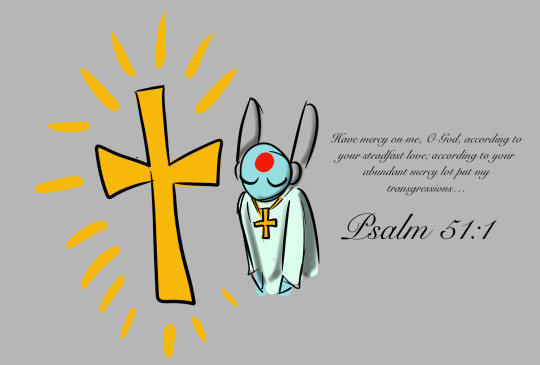



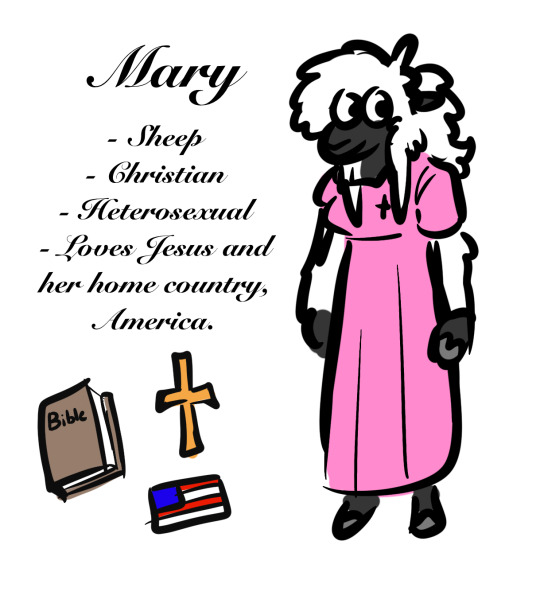
#rain world#rain world fanart#rainworld#Christian#christian blog#intro post#looks at the moon#looks at the moon rain world#rain world moon#various other fandoms
29 notes
·
View notes
Text
The rape of the Goddess in all of her aspects is an almost universal theme in patriarchal myth. Zeus, for example, was a habitual rapist. Graves points out that Zeus's rapes apparently refer to Hellenic conquests of the Goddess's ancient shrines. The early patriarchal rapes of the Goddess, in her various manifestations, symbolized the vanquishing of woman-identified society. In the early mythic rapes, the god often assumed a variety of animal forms; the sense of violence/ violation is almost tangible. In christianity, this theme is refined—disguised almost beyond recognition.
The rape of the rarefied remains of the Goddess in the christian myth is mind/spirit rape. In the charming story of "the Annunciation" the angel Gabriel appears to the terrified young girl, announcing that she has been chosen to become the mother of god. Her response to this sudden proposal from the godfather is totaled nonresistance: "Let it be done unto me according to thy word." Physical rape is not necessary when the mind/will/spirit has already been invaded. In refined religious rapism, the victim is impregnated with the Supreme Seminal Idea, who becomes "the Word made flesh."
Within the rapist christian myth of the Virgin Birth the role of Mary is utterly minimal; yet she is "there." She gives her unqualified "consent." She bears the Son who pre-existed her and then she adores him. According to catholic theology, she was even "saved" by him in advance of her own birth. This is the meaning of the "Immaculate Conception" of Mary— the dogma that Mary was herself conceived free of "original sin" through the grace of the "savior" who would be born of her. This grace received in advance, described by theologians as "grace of prevention or preservation," is something like a supernatural credit card issued to a very special patron (matron). Mary's credit line was crossed before she was even conceived. Double crossed by the divine Master Charge system, she was in a state of perpetual indebtedness. Still, as I have explained elsewhere, despite all the theological minimizing of Mary's "role," the mythic presence of the Goddess was perceivable in this faded and reversed mirror image.*
* In order to understand the Background of Mary, Hags should recall that she was known as "the new Eve." This leads us to look into the Background of Eve who, in hebrew myth, was a dulled-out replacement for Lilith, Adam's first wife. Patai writes of Lilith as portrayed in the Talmudic period: "When Adam wished to lie with her, Lilith demurred: 'Why should I lie beneath you,' she asked, 'when I am your equal since both of us were created from dust?'" (See Raphael Patai, The Hebrew Goddess, p. 210.) Any Crone-ographer, of course, can recognize this as a watered-down version of what Lilith really might have said, which would hardly have been an argument for mere "equal rights." As for Eve, constructed from Adam's rib—Peggy Holland has pointed out that this is an interesting mythic model: the first male-to-constructed-female transsexual. Patai affirms that it was Lilith who persuaded Eve to eat of the Tree of Knowledge and he acknowledges that Lilith was a Hag (pp. 210-13). According to Cirlot, Lilith, in the Israelite tradition, corresponds to the Greek and Roman Lamia. (See J. E. Cirlot, A Dictionary of Symbols, trans. by Jack Sage [New York: Philosophical Library, 1962], p. 180.) Graves puts more of the pieces together, indicating that Lamia was the Libyan Neith, also named Anatha and Athene. (See Robert Graves, The Greek Myths, I, 61, 1. Graves adds that "she ended as a nursery bogey" (which is, of course, the fate of all Hags/ Crones/ Witches in patriarchal myth). Lilith is also identified with Hecate, the lunar goddess and "accursed huntress." After pointing this out, Cirlot remarks: "The overcoming of the threat which Lilith constitutes finds its symbolic expression in the trial of Hercules in which he triumphs over the Amazons" (Ibid., p. 180). Since Hecate was associated with hares, this suggests that rabbits are in the Virgin Mary's Background. Given the parthenogenetic propensities of rabbits and given the reversal mechanisms of patriarchal myth, this association makes sense. We are also led to think about the identity of the familiar "Easter Bunny" (and about the reversal involved in the image of "Playboy Bunnies"). Finally, when considering Lilith, Hags should note that this name is said to be derived from the Babylonian-Assyrian word lilitu, meaning a "female demon, or wind-spirit." (See Robert Graves and Raphael Patai, Hebrew Myths: The Book of Genesis [Garden City, N.Y.: Doubleday, 1964], p. 68.) This is interesting in view of the fact that the name of the "Holy Spirit," who is believed to have impregnated the Virgin Mary, is derived from the Latin spiritus. Is the holy spirit trying to copy Lilith? Also fascinating is the thought that since, as we have seen, Yahweh is a derivative and reversal of the Goddess, one of whose primary names is Lilith, he is exposed as an imposter, a female impersonator, and a transsexed caricature of that Great Hag herself.
-Mary Daly, Gyn/Ecology
39 notes
·
View notes
Note
The Satanic Temple also still uses St. Peter's Cross. You know, the one that actually symbolizes the martyrdom of Peter who requested be ce crucified upside down, because he didn't saw himself worthy of dying the same way Christ did?
At one point some theologians even argued that wearing it was a bigger sigh of devotion than a regular one. Until an occultist Eugène Vintras figured "Well, if the regular cross means Christianity, then the upside down one must mean the opposite!"
Then the misconception got picked up by the media. So now we have this "religious movement" going along with something that's essentially a product of ignorance and pop culture. So my apologies for not taking them seriously.
I completely agree, Satanism is a Larp.
30 notes
·
View notes
Note
My dear friend,
Do you have any interesting Adam and Eve legends? I'm not talking about the apocryphal gospels in particular, because I know a little about them.
Hey there! Not sure when you sent this, hopefully you weren't waiting for too long. Ah, there's a lot of folklore that could be looked at.
For example, there's a theme in some Islamic and Jewish folklore that Adam and Eve actually separated for a length of time after their expulsion from the Garden of Eden. This may have been a conscious choice on their part, or they may have been separated during their expulsion. In some versions, Eve is already pregnant with Cain at this time, and it is Eve's wails while giving birth that draws Adam back to her. In other versions, Eve may not yet be pregnant. In some accountings, the demon Lilith impregnates herself from Adam's wet dreams and produces a race of demons.
There's a story where Adam created by dust that angels had collected from all corners of the world, so that his creation is in some sense an epitome of all Creation. (The fact that he is created from dust from all over the world is also an etiological explanation for why there are so many different skin colors among humans).
There is a legend that Adam was buried under Golgotha; Christ's Precious Blood spilled onto and soaked into the ground where he was buried. You can see this motif in some Crucifixion icons that depict a human skull (Adam's skull) under the Cross.
The number of children that Adam and Eve have vary wildly by source; some Irish sources suggest 100 children, 50 of each sex; we have a surviving monks' trivia game that says that Adam and Eve had 63 children, 33 boys and 30 girls. The lowest number I know is 14 children total. These are all postlapsarian children, by the way; some theologians speculated that Adam and Eve may have had sinless children in the Garden of Eden, beings we now know as faeries.
Speaking of children, one Islamic tradition says that Eve always gave birth to twins; a boy and a girl, a future husband and wife. According to this story, Cain killed Abel because Cain wanted to marry Abel's twin sister and not his own.
More children stories! In one tale recorded by the Brothers Grimm, Adam and Eve had many, many children. When God came to bless them with vocations, Eve was ashamed at the ugliness of some of them, so she hid them away while presenting the beautiful ones. When she saw God bless them with destinies like becoming scholars, knights, and princes, she called the ugly ones out. By that point, all the cool vocations were handed out, so they got destinies like becoming peasants, tanners, and sailors. And that's why.... us commonfolk are ugly???
At least some Rabbinic sources attribute Psalm 92 to Adam and the angels.
Oh! And Adam and Eve may have brought plants from the Garden of Eden to our fallen world; it may be a particular tree in Kashmir, clover, or maybe wheat.
#asks#Christianity#Judaism#Islam#Adam and Eve#religious folklore#Book of Psalms#faerie tale#faerie#Cain and Abel#Lilith#Jesus Christ#Crucifixion#Precious Blood#Brothers Grimm#folklore#Garden of Eden#Kashmir
24 notes
·
View notes